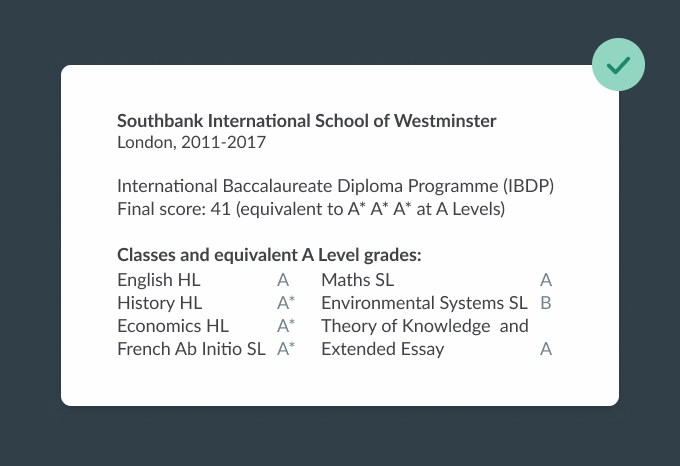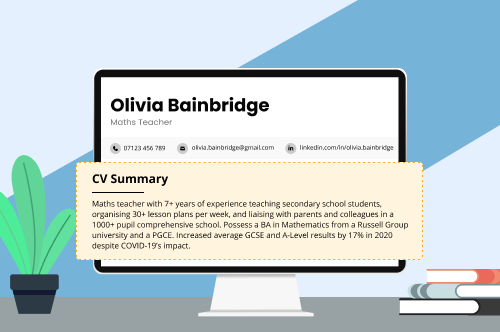Your CV education section is the part of your CV layout that highlights your formal training, including qualifications you obtained through school, university, and other education providers.
Standard CV education sections may include any of the following qualifications:
- University degrees
- Higher nationals and similar diplomas
- Apprenticeships
- A Levels, T Levels, BTECs, Scottish Highers, and similar Level 3 NVQs
- GCSEs and similar Level 2 NVQs
Formatting your education section correctly makes your training and qualifications more noticeable. Unsure of how to write a great CV with an effective education section? Read on for an education section example and tips for formatting specific qualifications.
Or view the video guide below for a five-minute overview of how to write your education section.
Does creating an education section seem too complicated or time-consuming? Use an online CV maker instead, and build a CV in minutes.
CV education section example
Here’s what an education section looks like when properly formatted on a CV:

How to write an impressive CV education section
Writing a CV education section can be confusing, but there are several ways for making the process trouble-free.
1. Place your CV education section strategically
If you’re writing a CV as a university student or applying for a job as a school leaver, you should put your education section first in your CV outline. Employers will be more interested in your education in these scenarios because you won’t have much work experience yet.
Sometimes employers want to look at your CV education first
Let’s say you’re applying for a graduate role in accounting and have an accounting degree as well as some part-time work experience at Morrisons.
You should place your CV’s education section above your work experience section because your degree and the units you studied are more relevant to the role than your supermarket job.
By contrast, if you have a few years of relevant work experience, place your education section after your work experience because employers will be more interested in your work-related achievements and the skills on your CV.
2. List your relevant qualifications
List any formal qualifications employers will want to know about. You should order your qualifications starting with the highest level certification you obtained.
There’s no maximum number of qualifications you can add to your CV education section, but remember your CV should only be 1–2 pages long. Only include qualifications you gained recently or are highly relevant to the job you’re applying for.
Furthermore, if you have two or more post-16 qualifications (e.g., you have A Levels and a university degree), you should leave out your GCSEs to save space on your CV. GCSEs are a requirement for most post-16 qualifications, so employers will assume you already have them.
3. Add relevant classes and courses
Adding relevant classes and courses to your CV education section shows employers that you have the technical knowledge for the job and can make your application stand out.
For example, if you’ve taken diverse courses in the past (e.g., A Levels in French, Biology, and Business Studies), including them on your CV demonstrates that you’re a well-rounded candidate.
Still, remember that adding individual classes takes up space on your CV, so you should consider their relevance to the job, and whether it would be better to highlight other skills or experience instead.
Putting specific qualifications on your CV
Knowing how to format your specific qualifications on your CV properly is crucial to highlighting your formal education to employers.
Here’s an overview of the qualifications you can add to your education section and how to add each of them correctly:
- Higher education qualifications
- Apprenticeships
- Sixth form and equivalent qualifications
- Year 11 and equivalent qualifications
Higher education qualifications
If you have a doctorate, master’s degree, bachelor’s degree, or level 6 National Vocational Qualification (NVQ), list these first (in that order, top to bottom). Put higher education degrees first so employers can immediately see that you’ve completed higher education.
List any postgraduate or undergraduate degrees, whether or not they have a direct link to the job you’re applying to.
Because these qualifications involve a significant amount of self-study and theoretical learning, they tell employers you have critical thinking skills, motivation, and other skills that are valuable across industries.
University degrees
For each degree you add to your CV, you should include the following
- Type of qualification (Ph.D, M.B.A, MA, BSc)
- Degree title
- Your degree classification (e.g., 1st, 2.1, merit, distinction)
- Name of the institution
- The dates you attended (or expected graduation date)
For example:

You can write out your degree classification in words if you’ve got plenty of space on your CV, or if you want to save space, you can use numbers:
- First-class honours: 1st
- Second-class honours (upper division): 2.1, 2:1, II.i, 2.i
- Second-class honours (lower division): 2.2, 2:2, II.ii, 2.ii
- Third class honours: 3rd
You don’t have to include your degree classification on your CV if you don’t want to. However, certain grades are considered a minimum requirement in certain professions. For example, you’ll often need a 2:1 to find work in law, consulting, or finance. Consider what employers want to see before you cut anything from your education section.
If you have a master’s degree, you’ll have been awarded a distinction, merit, or pass mark. If you got a distinction or merit grade, include it in your education section entry to highlight your excellent academic performance.

Higher National qualifications
If you’ve completed a Higher National qualification, such as a Higher National Certificate (HNC) or a Higher National Diploma (HND), list them after any university degrees that you have.
For each qualification you should include the following:
- The awarding institution
- Date of completion
- Any noteworthy grades (distinction, merit)
Here’s how a Higher National qualification looks on a finished CV:
University of South Wales | Cardiff, 2016 – 2020
HND Mechanical Engineering
Merit
Apprenticeships
Apprenticeships represent different levels of education from programme to programme. So you should list your apprenticeship relative to its difficulty. For example, a Level 4 apprenticeship should come after a university degree but before an A Level qualification.
Write an apprenticeship entry as you would any other formal qualification. If you gained a university degree through your apprenticeship, be sure also to include the type of degree you obtained:
North West Ambulance Service | Greater Manchester, 2020 – 2022
BSc (Hons) Paramedic Science Degree Apprenticeship
Sixth form and equivalent qualifications
If you don’t have a degree, start your education section with your A Levels (and AS Levels if applicable) or Level 3 National Vocational Qualifications (NVQs).
School leaver and other Level 3 qualifications can provide employers with valuable insights into areas of your knowledge that weren’t covered by your university or vocational training.
However, if your CV education section is already quite long (e.g., you have multiple university degrees), you can leave them off your CV to save space.
A Levels
You should list each A (and AS) Level separately, along with your grades. Here’s what that should look like:
Royal York Academy and Sixth Form | York, 2015–2022
A Levels: Physics (B), Maths (C), Chemistry (B)
If you’re writing a CV with no work experience, listing your A Levels in columns can help fill up space and highlight your individual areas of study:

T Levels
T Levels are Level 3 industry-focused qualifications that are gradually replacing most BTECs.
As T Levels were introduced relatively recently, there is no set rule for how you should write them on your CV. Employers also might not be familiar with T Levels, so if space allows you, briefly outline what you did for the qualification and what it taught you.
Example of T Levels on a CV:
Croydon College | Croydon, 2020 – 2022
Building Services for Construction (T-Level)
- Developed technical skills for key areas of construction, including plumbing, heating, and electrical services
- Completed 9-week work placement with Pimlico Plumbers, where I received glowing feedback for my consistent attention to detail and strong work ethic
BTECs
BTECs are vocational qualifications that are equivalent to A Levels.
List BTECs as you would any NVQ qualification:
Leyton Sixth Form College | London, 2017 – 2019
BTEC Level 3 Extended Diploma (Distinction)
If you obtained your BTEC at the same time as another Level 3 qualification, such as an A Level, you can list them under the same entry:
North Kent College | Dartford, 2019 – 2021
A Levels: English (B), Psychology (B)
BTEC National Diploma in Film and Television Production (Merit)
Scottish Highers
If you studied in Scotland, you likely took Nationals and Advanced Highers.
Here’s an example of how you can put Scottish school qualifications on your CV:
The Royal High School | Edinburgh, 2016–2021
Highers: Maths (A), Physics (B), Chemistry (A), Computing Science (A)
N5s: English (C), Maths (A), Geography (B), Physics (A), Chemistry (A), Computing Science (B)
If you’re applying to a business you don’t think will be familiar with Scottish qualifications (such as a small start-up or firm outside the UK), provide approximate equivalences so that employers can easily understand your level of education:
The Royal High School | Edinburgh, 2016–2021
Scottish Highers: Maths (A), Physics (B), Chemistry (A), Computing Science (A) — equivalent level to A Levels
Scottish N5s: English (C), Maths (A), Geography (B), Physics (A), Chemistry (A), Computing Science (B) — equivalent to 10+ GCSEs
You don’t need to provide equivalent A Level grades if you’re applying for jobs at large companies in England, Wales, or Northern Ireland. Their HR departments will be familiar with Scottish qualifications.
International Baccalaureate
Some schools in the UK use the International Baccalaureate (IB) instead of A Levels.
If you have an IB, provide your final score out of 45, and then add equivalent A Level grades:
Southbank International School Westminster | 2020–2022
International Baccalaureate Diploma Programme (IBDP)Final score – 41 (Equivalent to A* A* A* at A Level)
As with A Levels, adding individual courses you took as part of your IB is a good way of filling up space on your CV if you don’t have much formal experience.

Remember, employers might not be familiar with the IB grading system. So if you want to include grades for individual classes, express them in A Level equivalents to make the entry easier to read.
Year 11 and equivalent qualifications
You’ll need to have English, maths, and science GCSEs to do most jobs in the UK. However, it’s normally only useful to include GCSEs if you’re writing your CV while still in college or don’t have Sixth Form- or university-level qualifications.
On the other hand, you should always include your Level 2 qualifications if they’re important for the role. For example, a Level 2 Certificate in Childcare if you’re preparing a CV for a Nursery Assistant job.
GCSEs
If you studied your GCSEs and A Levels at the same school, list them both under the same entry. Or if you went to a sixth-form college to study your A Levels, add them to a separate education section entry.
Level 2 NVQs
Add Level 2 NVQs as you would any other national qualification, including:
- The awarding institution
- Qualification name
- Year awarded
- Grade obtained (optional)
Birmingham Metropolitan College | 2021
Level 2 NVQ Certificate in Pharmacy Services Skills
Frequently asked questions about your CV education section
Still have doubts about putting your qualifications on your CV? Here are three common questions about writing a CV education section in the UK:
1. How do I put study abroad on my CV?
If you studied abroad for a year as part of your degree, you can add it to your CV as its own education entry or as part of your main degree entry.
To make a separate entry for your study abroad experience, list the study abroad programme using the same format you would use for a regular degree. Make sure you include the following:
- University name
- Programme you were on
- Dates you studied abroad
- Honours you received (if applicable)
Here’s an example of a properly formatted study abroad entry:
Universidad Autónoma de Madrid | 2018 – 2019
Degree in Modern Languages, Culture, and Communication (exchange year)
And here’s how to include your study abroad experience as part of your main degree entry:
University of Leicester | 2018 – 2022
BA (Hons) Ancient History and History
Relevant modules: Approaching Ancient Evidence, The Shock of the Modern, Global History: Connections and Cultures in a Changing WorldStudy abroad year at National & Kapodistrian University of Athens (2020 – 2021)
2. Should I put student union or student society roles on my CV?
Putting student union or student society roles on your CV is an effective way of demonstrating portable skills, like organisation and project management. Therefore, it’s a good idea to mention such extracurricular activities in your CV if you don’t have much formal work experience.
To put student union or student society experience on your CV, you should:
- note the role in your education section
- write a separate work history entry with more detail
Here’s how a society role might look on your CV:
Add your student union experience to your education section like this:
University of Northumbria | Newcastle, 2017–2020
BA (Hons) Graphic Design (2.1)
- President, University of Northumbria Public Speaking Society (2018–19)
And here’s how you should enter your student union experience in your work history section:
Include student union experience as a work history entry:
University of Northumbria Public Speaking Society, 2018–19
President
- Organised 12 monthly public speaking events
- Collaborated with local MPs, councillors, and business leaders to arrange 3 ‘VIP’ public speaking master classes
- Implemented ‘taster’ sessions idea, for newcomers to practise public speaking in small groups of 5 before the whole group, increasing membership by 47%
3. Can I include internships in my education section?
Internships can be a valuable feature on your CV when you’re starting a new career. However, it’s best to add internship experience to your work history section.
Here’s what a properly formatted internship entry looks like:

Notice how each bullet point contains numbers? Numbers are eye-catching and give employers a clear picture of what you can achieve.
If you did a short internship — for example, during the summer holidays — you don’t need to be too specific with the dates. For example:

Additional FAQs about writing your CV
Here are the answers to even more questions you might have about writing a great CV:






